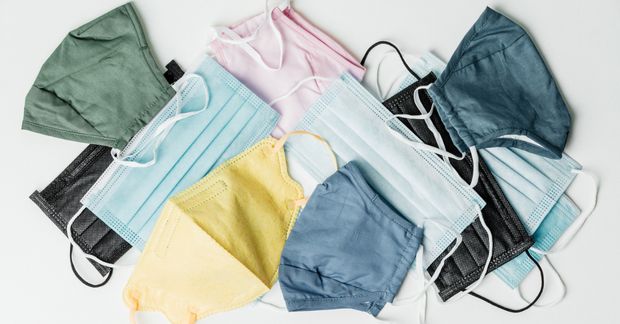Updated April 17, 2023
Since the start of the pandemic, mask guidelines have evolved as public health officials continue to gather information on the spread of SARS-CoV‑2, the virus that causes COVID-19. Masks have proven to be a critical tool in protecting both yourself and others from spreading the virus. However, masking guidelines can be intimidating to keep up with as there are many changing recommendations around which masking techniques best protect you.
When to wear a mask
Unvaccinated people
It is recommended that unvaccinated people over the age of 2 wear a mask when they may encounter another person outside of your household, according to the Center for Disease Control and Prevention (CDC). Masks help slow the spread of COVID-19 by shielding you and others from respiratory droplets that are released when someone talks, coughs or sneezes.
In Duly Health and Care Clinics
Masking is now optional* for all Duly Health and Care locations and we will no longer universally limit the number of visitors that adult patients have. Those who wish to continue to mask are encouraged to do so.
*Masking will continue to be required when patients/visitors display cough, cold, flu-like illness, and/or fever.
To help keep our patients and their families healthy, we are currently offering the flu vaccine and bivalent COVID boosters for patients.
In Public Spaces
The CDC recently announced that vaccinated individuals no longer have to wear a mask when around other people both indoors and outdoors1. You are considered fully vaccinated two weeks after your final dose. Even though you are vaccinated, if you are feeling ill, you should wear a mask. This new masking guideline excludes public places, including schools, healthcare facilities, restaurants, stores and event venues that require you to wear a mask. As of April 18, 2022, masks are no longer required on planes, buses, trains or other forms of public transportation within the United States.
Types of masks2
Regardless of which type of mask you choose to wear, it is important to find one that fits properly to your face and does not gape open on the sides.
- KN95 masks
- Disposable
- This type of mask is made of the same synthetic material as N95 masks that are currently reserved for healthcare workers. Both get their name due to the masks filtering out and capturing 95 percent of particles.
- Cloth masks
- Reusable
- This mask should have 2 – 3 fabric layers of breathable material such as cotton.
- Non-medical disposable masks
- Disposable
- Ideal for situations in which your mask may get wet or dirty.
- Neck gaiters or bandanas
- Reusable
- While neck gaiters and bandanas do not fulfill the masking requirements in healthcare settings, schools, federal properties or on public transportation, these alternatives are better than no face mask at all when a mask is needed. Gaiters and bandanas should have two layers of fabric and be secured properly to your face to be the most effective.
Double Masking
As a result of more contagious, mutated strains of the COVID-19 virus making their way to the United States, the CDC began to study the effectiveness of wearing two masks at once. Their findings, released February 10, 2021, found that wearing a non-medical disposable mask under a cloth mask increases the mask’s effectiveness in blocking out contagious respiratory particles3. For added effectiveness, you can tie the disposable mask’s ear loops in a knot behind your ear for a tighter fit. This will help close in any of the mask’s gaps on the side of your face and, as a result, increase your protection from COVID-19.
Caring for your masks
If you plan on reusing your mask throughout the day, it is recommended that you store your mask in a paper bag after proper removal. To remove your mask properly, grab the loops that secure your mask to your ears and then fold the mask’s outside corners together. This will help preserve the cleanliness of the inside of the mask for future use. To wash a reusable mask, you can include it with your other laundry at the appropriate washer setting. Masks should also be fully dried before your next use4.
If your mask is disposable, you should throw out your mask after a single use or change into a new one if the mask becomes wet or dirty.
Continued masking
As we continue to learn about COVID-19 and more research is done by experts in the field, unvaccinated people need to maintain their current safety practices including social distancing and masking. Masking remains a critical element in the fight against COVID-19 and masking guidance updates should continue to be followed as they evolve.
To stay up-to-date on the latest COVID-19 information, visit our COVID-19 Updates page.
Sources
1Your Guide to Masks. (2021, January 30). In Centers for Disease Control and Prevention. Retrieved from https://www.cdc.gov/coronavirus/2019-ncov/prevent-getting-sick/about-face-coverings.html
2Maximizing Fit for Cloth and Medical Procedure Masks to Improve Performance and Reduce SARS-CoV‑2 Transmission and Exposure, 2021 (2021, February 10). In Centers for Disease Control and Prevention. Retrieved from https://www.cdc.gov/mmwr/volum…
3How to Store and Wash Masks. (2020, October 8). In Centers for Disease Control and Prevention. Retrieved from https://www.cdc.gov/coronavirus/2019-ncov/prevent-getting-sick/how-to-wash-cloth-face-coverings.html
4Silberner, J. (2021, January 12). Why You Should Still Wear A Mask And Avoid Crowds After Getting The COVID-19 Vaccine. In NPR. Retrieved from https://www.npr.org/sections/health-shots/2021/01/12/956051995/why-you-should-still-wear-a-mask-and-avoid-crowds-after-getting-the-covid-19-vac
Health Topics:

